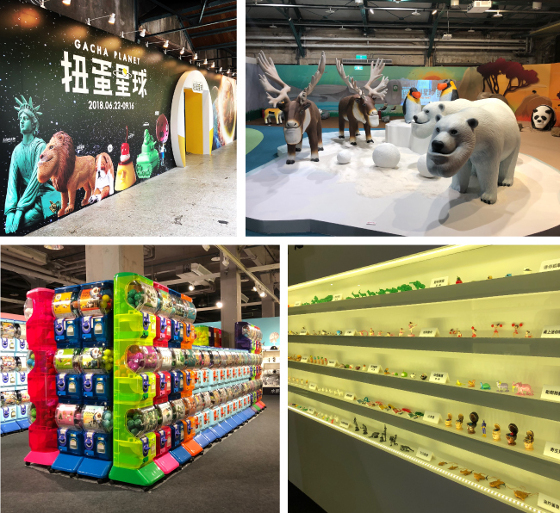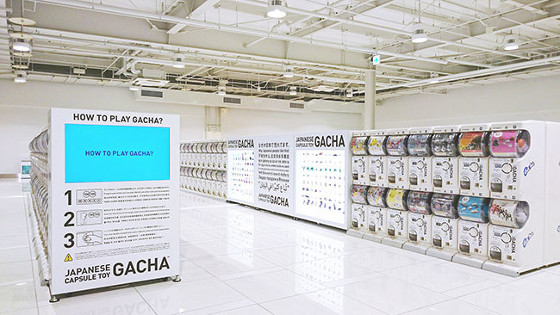
Five Strategic Ways to Promote Capsule Toys to Adults

Japan’s tourism industry is booming as the government works to attract 40 million tourists to the country by 2020. Parallel with the influx of visitors from overseas, there has been an increase in the popularity of miniature toy figurines jointly developed by Dentsu Tec Inc. and Takara Tomy Arts Co., under the brand name “PANDA’S ana” (‘ana’ means den in Japanese).
Sold in small plastic capsules, the toys have attained sales three to five times higher than had been anticipated.
The toys—as also their vending machines—are commonly referred to as gachapon in Japan. The term is an onomatopoeia based on the sound of the vending machine crank and the thud the capsules make when spat out.
Driven by extensive media coverage, the popularity of the toys has even fueled the success of the brand’s promotional events abroad.
To help us understand the reason for the toys’ popularity, we spoke with Masami Iida, a Dentsu Tec senior creative director who was involved in the project to promote the capsule toys.
Offloading loose change
We saw in the increasing number of people using the country’s airports as an opportunity to start a new business. So we started off by creating capsule toy vending machine areas at some airports.
We were counting on the attraction for tourists leaving the country being that, by buying these capsule toys, they could get rid of any remaining small change they might have in yen.
Given that some 28 million overseas tourists visited Japan in 2017, we have since calculated that, had each of them spent ¥1,000 (about US$10 dollars) on these toys, sales would have reached around ¥28 billion. Thus, by giving tourists a chance to use up their Japanese coins on toys that cost only ¥200 each, we expected the capsule toy business to post solid sales.
In June 2016, vending machine areas were set up in airports for a limited time and the response was very good: sales of capsule toys were excellent and media coverage heavy. Since then, the toy vending machines have been installed at a total of 20 national airports.
In addition, promotional events have been held abroad. They include two exhibitions in Taiwan, organized by the PANDA’S ana brand, which Dentsu Tec licenses in Taiwan. Titled Gacha Planet, the exhibitions—which opened on June 22 and ran until September 16—speak to the spreading popularity of the brand.

Gacha Planet exhibitions were held simultaneously in Taipei and Kaohsiung, Taiwan, from June 22 to September 16 this year. The events attracted a combined total of 59,850 visitors, boosting the brand’s popularity in Taiwan
Basic Strategies for Creating Hit Products
Our target customers are mainly the tourists from overseas who pass through our airports. But, since most of these people are not familiar with Japanese toys sold from vending machines, and might even regard such items as just cheap children’s toys, we came up with five ways to attract their attention.
1. The unexpected
First of all, we had to make people notice the toy vending machines areas. So, instead of installing single vending machines, we arranged numerous machines in rows. We figured that, were users to come across something presented in an unusual way in a public facility, such as an airport, it would be certain to attract their attention.
2. Multilingual instructions
Next, near the vending machines we placed signs, written in several languages, inviting people to spend their left-over change on buying a capsule toy.
Since people travelling abroad naturally notice signage in their own language, we thought tourists would surely notice the messages.
3. Adult focus
Most airport users are adults, and adults visiting from abroad generally imagine that toys sold in capsules are just cheap items for children.
Changing this basic perception was a major challenge. Eventually we decided to design the vending machine spaces in such a way as would make the products appear like works of art in a small gallery. We used off-white as the main color in the spaces, and a simple font for the multilingual signs. This, we hoped, would encourage adults to take a close look at the vending machines.
4. Quality, low-priced items
Our goal was to make people realise, when taking a close look at the vending machines, that the products being sold are interesting and better made than one might expect.
The toy figurines are detailed, well made, quality products. Indeed, I believe it would be hard to find many products anywhere of such quality for only ¥200 (about US$2).
5. Social networks to the rescue
From the start, having no advertising budget to fund our capsule toy campaign, we had to rely on social networking services to spread word about the campaign.
We posted photos of PANDA’S ana toys on various sites and found that people—including overseas tourists—responded with photos of toys they had purchased. The more snapshots that appeared online, the more the products were promoted.
I believe the campaign was well received and we were effective in tapping into the popularity of social media, especially in Taiwan. The growing number of photos taken at our events and posted online convinced me that our campaign had gone over well.
I am sure that the products became such a hit because we took our chosen approaches right from the start. Airports, moreover, remain largely untapped marketplaces that offer excellent business conditions: open around the clock, people waiting for flights have both time to look around and loose change left over.
Finally, I am sure that toys sold from vending machines have universal appeal. Regardless of their culture, people find it fun to turn the knob on the machine and see what toy pops out. The combination of marketing techniques and circumstances thus has made capsule toys and airport vending machine areas really popular.
In the next instalment of this series, I will explain how the toys are made with such quality—a big factor behind their popularity—and consider our outlook for the future.

The vending machine area at Kansai International Airport













